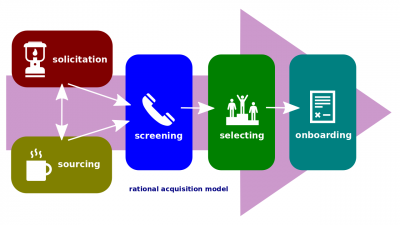Difference between revisions of "Rational Acquisition Model"
(→Stages) |
|||
| Line 6: | Line 6: | ||
#[[Sourcing]]. [[Enterprise effort]]s undertaken in order to identify and list possible sources, internal and/or external, that are potentially capable to provide the specified [[organizational resource]]s, as well as potential [[data source]]s who are able to provide relevant information on specific procurement. | #[[Sourcing]]. [[Enterprise effort]]s undertaken in order to identify and list possible sources, internal and/or external, that are potentially capable to provide the specified [[organizational resource]]s, as well as potential [[data source]]s who are able to provide relevant information on specific procurement. | ||
#[[Source screening]]. (1) The evaluation or investigation of a [[source]] as part of a methodical [[survey]], to assess suitability for a particular role or purpose; (2) Techniques used for [[source consideration]], reviewing, analyzing, [[ranking]], and selecting the best alternatives for the proposed action. | #[[Source screening]]. (1) The evaluation or investigation of a [[source]] as part of a methodical [[survey]], to assess suitability for a particular role or purpose; (2) Techniques used for [[source consideration]], reviewing, analyzing, [[ranking]], and selecting the best alternatives for the proposed action. | ||
| − | #[[Source settlement]]. An official agreement between an [[enterprise]] and its selected source intended to settle the acquisition. | + | #[[Source settlement]]. An official [[agreement]] between an [[enterprise]] and its selected source intended to settle the acquisition. |
| − | |||
==Related lectures== | ==Related lectures== | ||
Revision as of 04:26, 8 December 2020
Rational acquisition model (hereinafter, the Model) is a model that describes how enterprises may rationally behave in order to carry out best source valuation and maximize the outcomes from their acquisitions.
Stages
- Source solicitation. Enterprise efforts undertaken in order to obtain information about possible sources and, possibly, their quotations, bids, offers, or proposals as appropriate.
- Sourcing. Enterprise efforts undertaken in order to identify and list possible sources, internal and/or external, that are potentially capable to provide the specified organizational resources, as well as potential data sources who are able to provide relevant information on specific procurement.
- Source screening. (1) The evaluation or investigation of a source as part of a methodical survey, to assess suitability for a particular role or purpose; (2) Techniques used for source consideration, reviewing, analyzing, ranking, and selecting the best alternatives for the proposed action.
- Source settlement. An official agreement between an enterprise and its selected source intended to settle the acquisition.
